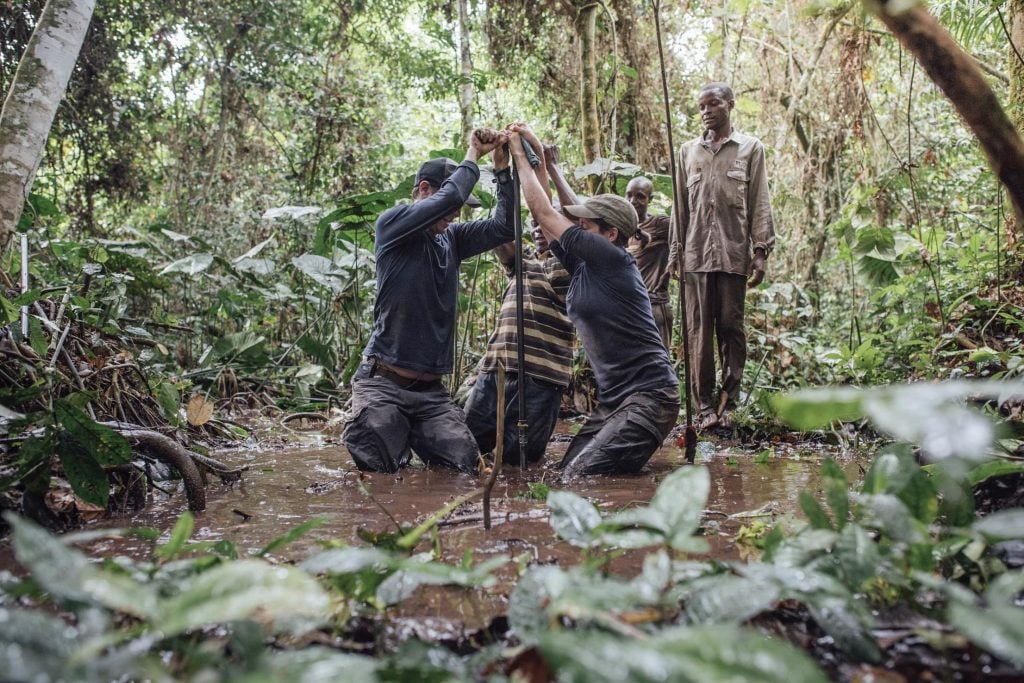Scientist have confirmed the presence of peatlands in the Democratic Republic of Congo after an expedition in the village of Lokolama (45 km from Mbandaka – capital of the province of Equateur in the Democratic Republic of Congo).
The first Congo Basin peatlands map was published in January 2017, in the journal Nature, using data from the Republic of Congo. The search for peat in Democratic Republic of Congo began with the expedition to Lokolama, confirming the presence of peat, with a discovery of peat to a depth of 3.5 metres.

As indigenous people, peatlands are part of our heritage and their discovery for the world to see represents a great hope for future generations. Photo Credit/Greenpeace
A team of UK and Congolese tropical forest scientists including Professor Simon Lewis and Dr Greta Dargie from the University of Leeds, UK, estimated that the peatlands of the central Congo Basin span 145,500 square kilometres, and store some 30 billion metric tonnes of carbon. This amount of carbon is equivalent to three years of the world’s fossil fuel emissions. This places the Central Congo Basin peatlands as the world’s most extensive tropical peatland complex.
Dr Greta Dargie said: ”Arriving in Lokolama and going to the swamp forest with our partner Dr Corneille Ewango of the University of Kisangani and the local community to discover that our mapping in this part of DRC was accurate was a relief. The surprise was that the peat was 3.5 metres deep so close to the edge of the Lokolama peatland. These two initial results show how important it is to invest in Congolese science to allow many more locations to be assessed for peat depth and carbon storage in the DRC. This will produce better maps of the peatlands in the future.”
Peat is an organic wetland soil made from partially decomposed plant debris. Healthy peatlands act as a carbon sink. Growing plants remove carbon from the atmosphere, but when they die they normally decompose returning the carbon to the atmosphere. In year-round waterlogged tropical swamp forest the decomposition is only partial, leading to an accumulation of carbon as peat.
Greenpeace Africa (Greenpeace.com) is working with local communities in the DRC to develop alternatives to destructive logging and advocate that the Congo Basin forest be protected by keeping a 15 years old moratorium on the allocation of new logging concessions in place. The recent discovery of the peatlands adds urgency to the need to find development pathways that will radically improve local livelihoods and welfare without compromising the integrity of the ecosystem.
“As indigenous people, peatlands are part of our heritage and their discovery for the world to see represents a great hope for future generations. `We hope our government will support us in our role as guardians of this ancient forest and provide us with the needed support to safeguard peatlands for our children and for the world” said Valentin Egobo, Lokolama community spokesperson.
A major threat for the peatland is industrial logging. Of a total of 57 logging concessions in the DRC, at least 29, covering around 5 million hectares, are illegal. These illegal concessions overlap with approximately 650,000 hectares of peat swamp forest containing hardwood.
Greenpeace ship the Esperanza is currently in the DRC as part of a four week tour of the Central African coast, ‘Give the Congo Basin forest a chance’ ship tour. The findings from the peatland expedition are central to discussions between Greenpeace Africa, DRC government officials represented by the Environment and Sustainable Development Minister Amy Ambatobe, local and indigenous communities, civil society and donors taking place on board the ship in the port city of Matadi.
The Esperanza will make its way to the Republic of the Congo on November 6 to continue mobilising communities, civil society groups, government officials to create the needed attention on the importance of the Congo Basin forest for keeping the earth’s climate stable. For protecting biodiversity, and for the cultures and livelihoods of local and indigenous communities living in and around the forest. Meanwhile more scientific research will resume at the beginning of 2018.

Très bonne nouvelle. Possible de trouver d’autres réserves en RDC? Merci pour la recherche.
C’est une bonne nouvelle chers mesieurs. Possible de nous renseigner d’autres réserves de la tourbière en RDC?
La conservation de la reserve des tourbieres de Lokolama ne peut etre rendu efficace que par des actions conjuguées protection et réduction de la pauvreté en faveur des communautés locales